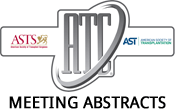2018 American Transplant Congress
Ultrastructural Changes in Lung Allografts: Endothelial Changes Correlate with Donor Specific Antibody & Antibody Mediated Rejection
Introduction: Antibody mediated rejection (AMR) causes lung allograft (LA) injury. Challenges with C4d interpretation & lack of specific histological criteria account for difficulty in diagnosing…2018 American Transplant Congress
Rapamycin Impairs Human Endothelial Cell Alloimmunogenicity Independent of PD-1/PD-1 Ligand Inhibitory Signaling
Department of Surgery, Duke University Medical Center, Durham, NC.
Rapamycin prevents costimulation blockade (CoB)-resistant rejection in mice and primates, and early human data suggests a similar salutary effect. We have hypothesized that one mechanism…2018 American Transplant Congress
Treg Regulate Distinct Lymphatic NFκB Signaling Pathways to Alter Migration and Immunity
Background: Treg migration to the graft and draining lymph nodes is crucial for graft survival. Little is known about the molecular cues that regulate the…2018 American Transplant Congress
CD40 Signaling in Proximal Tubules Regulates Fibrosis in Both Hypertension and Chronic Allograft Rejection
University of Toledo College of Medicine and Life Sciences, Toledo, OH.
Background: We explored the role of CD40 signaling in kidney proximal tubule epithelial cells on renal interstitial fibrosis (IF) in two models: hypertension; and chronic…2018 American Transplant Congress
CD4 T Cells Require Both S1PR1 and S1PR4 for Afferent Lymphatic Migration
1UMB, MD; 2NIH, MD; 3Boston Children's Hospital, MA; 4NYU, NY; 5U. Minnesota, MN.
Introduction: Sphingosine 1-phospate (S1P) receptor 1 (S1PR1) drives T cell migration from thymus into blood, and lymph nodes (LN) into efferent lymphatics. Whether S1PR1 and…2018 American Transplant Congress
Lymphatic Endothelium Requires S1PR2 for T Cell Transendothelial Migration
1UMB, MD; 2NIH, MD; 3Boston Children's Hospital, MA; 4NYU, NY; 5U. Minnesota, MN.
Introduction: Sphingosine 1-phosphate (S1P) receptors 1 (S1PR1) and S1PR2 are highly expressed by lymphatic endothelial cells (LEC), while T cells express S1PR1 and S1PR4. S1P…2017 American Transplant Congress
Apoptotic Exosome-Like Vesicles Released During Tissue Injury Trigger IL23/IL-17 Autoimmune Axis and Accelerate Rejection.
Autoantibodies to apoptotic antigens, such as perlecan/LG3, are present pre-transplantation and contribute to organ rejection. We previously showed that during tissue injury, apoptotic endothelial cells…2017 American Transplant Congress
TGF-β1 Induces Transplant Kidney Interstitial Fibrosis Through Endothelial-to-Mesenchymal Transition via TGF-β/Smad and Akt/mTOR/p70S6K Pathways.
Urology, The First Affiliated Hospital of Nanjing Medical University, Nanjing, Jiangsu, China
Background: Chronic allograft dysfunction (CAD) induced by kidney interstitial fibrosis is the main cause of allograft failure in kidney transplantation. Studies suggested that endothelial-to-mesenchymal transition…2017 American Transplant Congress
Modification of Human Endothelial Cells by CRISPR/Cas9-Mediated Ablation of Class I and II Major Histocompatibility Complex Antigen Expression.
Yale School of Medicine, New Haven, CT
Human endothelial cells (ECs) derived from cord blood progenitors have significant replicative potential and are thus well suited for use in tissue engineering of vascularized…2017 American Transplant Congress
Uptake of Extracellular Mitochondria Activates Human Endothelial Cells That Stimulate Alloreactive Effector T Cell Responses.
1Surgery, Duke University, Durham, NC; 2Immunology, Duke University, Durham, NC
Introduction: Vascular endothelial cells (VECs), the initial barrier between host immunity and donor allograft tissue, play a critical role in allograft rejection. We investigated the…
- « Previous Page
- 1
- …
- 11
- 12
- 13
- 14
- 15
- …
- 18
- Next Page »
